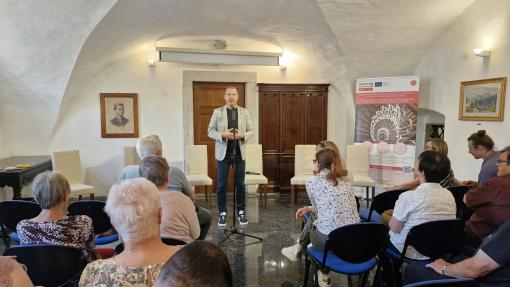The word "border" holds many meanings. From early childhood, children become aware of social boundaries. On the path to adulthood, one begins to understand the significance of regional and national borders, what benefits they bring and what they take away. Borders separate the known from the unknown, ours from theirs. Courage, curiosity, or the need to escape can take us across the border into the unknown—whether that be crossing a national border or discovering the culture of immigrants in our local area. Through this, we learn and discover whether the unknown is truly foreign to us, or whether, within the foreign, we can also find a trace of the familiar—and that we are, in essence, one.
On Friday, June 13, 2025, the Tolmin Museum organized evening talks on stories and life along the border. The phenomenon of borders was explored from various perspectives: cultural, historical, and geographical, all related to the border area between the Friuli Venezia Giulia Region and the Upper Soča Valley. The conversation also addressed best practices aimed at developing sustainable and cross-border cultural tourism.
Following welcome speeches by Mag. Tadej Koren, Director of the Tolmin Museum, and Ms Giulia Coradazzi from the Municipality of Tolmezzo the discussion was moderated by Dr. Marko Klavora from the Goriški Museum. Stories from the border were shared with the audience by the following guests: Dr. Aleksej Kalc, historian at the Slovenian Migration Institute (SMI) at the Research Centre of the Slovenian Academy of Sciences and Arts (ZRC SAZU), Ms Mara Černic, political scientist engaged for many years in national and international cultural projects; Ms Lojza Batistič (Luisa Battistig), caretaker of the Ethnographic Museum Varh Matajurja in the village of Mašera and president of the Mountaineering Society of Benečija; Mr Branko Medveš, owner of the tourist farm Jelenov breg pod Matajurjem and Aljaž Škrlep, member of the Robida association, which operates in the village of Topolò in Slovenian Friuli.
The topic of borders encouraged the guests to reflect on the many-layered aspects of human relations at the border and life in a geographically diverse area. Life in Trieste and its hinterland, and in the area of Gorizia and Nova Gorica, has been and still is different from life in the villages of Slovenian Friuli beneath Mount Matajur, or in the Slovenian villages on its other side. The border has left behind many stories, some tragic, and has shaped the destinies of people and families. Today, new stories are being written in this region. Although the villages along the border in the Upper Soča Valley are becoming depopulated, some young people see opportunities in them. One such individual is Aljaž Škrlep, from Nova Gorica who chose Topolò as his permanent residence. The Robida Association, made up of young artists and intellectuals, is reimagining rural life in a unique way. Ms Mara Černic specifically highlighted the example of the cross-border European Capital of Culture GO!2025, which is reshaping perspectives on the border space in the cities of Nova Gorica and Gorizia.
The evening concluded with a thought from Italian historian Luisa Passerini, quoted by Dr. Klavora:
"To be alone, local, provincial, capable of enduring—this is the only thing that gives substance to internationalism." The event at the Tolmin Museum was part of the cross-border literary festival titled "Tolmezzo – Vie dei Libri / Po knjižnih poteh", and it was the only event to take place outside the main venue. The festival was held in Tolmezzo from June 13 to 15, 2025. In its third edition, the festival received a cross-border character for the first time, made possible by the DANTE Project.

